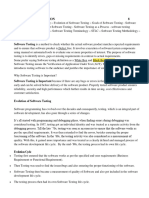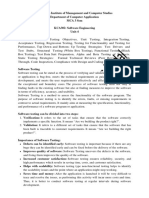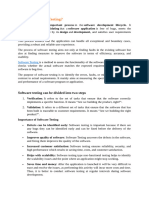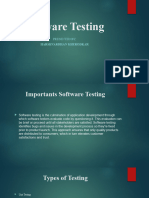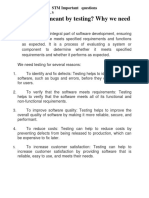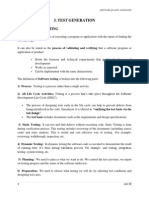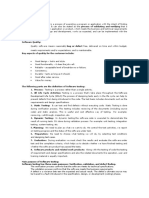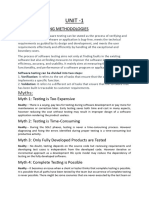0 ratings0% found this document useful (0 votes)
4 viewsSoftware Testing
Software Testing
Uploaded by
muhammadabdullahakram2002Software testing is a crucial process in the software development lifecycle that verifies and validates applications to ensure they are free of bugs and meet user requirements. It involves two main steps: verification and validation, and can be categorized into various types and techniques, including manual, automated, functional, and non-functional testing. The importance of software testing lies in early defect identification, improved software quality, increased customer satisfaction, and cost-effectiveness.
Copyright:
© All Rights Reserved
Available Formats
Download as DOCX, PDF, TXT or read online from Scribd
Software Testing
Software Testing
Uploaded by
muhammadabdullahakram20020 ratings0% found this document useful (0 votes)
4 views4 pagesSoftware testing is a crucial process in the software development lifecycle that verifies and validates applications to ensure they are free of bugs and meet user requirements. It involves two main steps: verification and validation, and can be categorized into various types and techniques, including manual, automated, functional, and non-functional testing. The importance of software testing lies in early defect identification, improved software quality, increased customer satisfaction, and cost-effectiveness.
Copyright
© © All Rights Reserved
Available Formats
DOCX, PDF, TXT or read online from Scribd
Share this document
Did you find this document useful?
Is this content inappropriate?
Software testing is a crucial process in the software development lifecycle that verifies and validates applications to ensure they are free of bugs and meet user requirements. It involves two main steps: verification and validation, and can be categorized into various types and techniques, including manual, automated, functional, and non-functional testing. The importance of software testing lies in early defect identification, improved software quality, increased customer satisfaction, and cost-effectiveness.
Copyright:
© All Rights Reserved
Available Formats
Download as DOCX, PDF, TXT or read online from Scribd
Download as docx, pdf, or txt
0 ratings0% found this document useful (0 votes)
4 views4 pagesSoftware Testing
Software Testing
Uploaded by
muhammadabdullahakram2002Software testing is a crucial process in the software development lifecycle that verifies and validates applications to ensure they are free of bugs and meet user requirements. It involves two main steps: verification and validation, and can be categorized into various types and techniques, including manual, automated, functional, and non-functional testing. The importance of software testing lies in early defect identification, improved software quality, increased customer satisfaction, and cost-effectiveness.
Copyright:
© All Rights Reserved
Available Formats
Download as DOCX, PDF, TXT or read online from Scribd
Download as docx, pdf, or txt
You are on page 1of 4
Testing
What is Software Testing?
Software testing is an important process in the software development lifecycle. It
involves verifying and validating that a software application is free of bugs, meets the technical
requirements set by its design and development, and satisfies user requirements efficiently and
effectively.
This process ensures that the application can handle all exceptional and boundary cases,
providing a robust and reliable user experience. By systematically identifying and fixing issues,
software testing helps deliver high-quality software that performs as expected in various
scenarios.
Software Testing is a method to assess the functionality of the software program. The process
checks whether the actual software matches the expected requirements and ensures the
software is bug-free. The purpose of software testing is to identify the errors, faults, or missing
requirements in contrast to actual requirements. It mainly aims at measuring the specification,
functionality, and performance of a software program or application.
Software testing can be divided into two steps
1. Verification: It refers to the set of tasks that ensure that the software correctly
implements a specific function. It means “Are we building the product right?”
2. Validation: It refers to a different set of tasks that ensure that the software that has
been built is traceable to customer requirements. It means “Are we building the right
product?”
Importance of Software Testing
Defects can be identified early: Software testing is important because if there are any
bugs they can be identified early and can be fixed before the delivery of the software.
Improves quality of software: Software Testing uncovers the defects in the software,
and fixing them improves the quality of the software.
Increased customer satisfaction: Software testing ensures reliability, security, and high
performance which results in saving time, costs, and customer satisfaction.
Helps with scalability: Software testing type non-functional testing helps to identify the
scalability issues and the point where an application might stop working.
Saves time and money: After the application is launched it will be very difficult to trace
and resolve the issues, as performing this activity will incur more costs and time. Thus, it
is better to conduct software testing at regular intervals during software development.
Different Types of Software Testing
Explore diverse software testing methods including manual and automated testing for
improved quality assurance. Enhance software reliability and performance through functional
and non-functional testing, ensuring user satisfaction. Learn about the significance of various
testing approaches for robust software development.
1. Manual testing – Involves manual inspection and testing of the software by a human
tester.
2. Automated testing – Involves using software tools to automate the testing process.
3. Functional testing – Tests the functional requirements of the software to ensure they
are met.
4. Non-functional testing – Tests non-functional requirements such as performance,
security, and usability.
5. Unit testing – Tests individual units or components of the software to ensure they are
functioning as intended.
6. Integration testing – Tests the integration of different components of the software to
ensure they work together as a system.
7. System testing – Tests the complete software system to ensure it meets the specified
requirements.
8. Acceptance testing – Tests the software to ensure it meets the customer’s or end-user’s
expectations.
9. Regression testing – Tests the software after changes or modifications have been made
to ensure the changes have not introduced new defects.
10. Performance testing – Tests the software to determine its performance characteristics
such as speed, scalability, and stability.
11. Security testing – Tests the software to identify vulnerabilities and ensure it meets
security requirements.
12. Exploratory testing – A type of testing where the tester actively explores the software
to find defects, without following a specific test plan.
13. Boundary value testing – Tests the software at the boundaries of input values to
identify any defects.
14. Usability testing – Tests the software to evaluate its user-friendliness and ease of use.
15. User acceptance testing (UAT) – Tests the software to determine if it meets the end-
user’s needs and expectations.
Different Types of Software Testing Techniques
1. Black box Testing: Testing in which the tester doesn’t have access to the source code of
the software and is conducted at the software interface without any concern with the
internal logical structure of the software known as black-box testing.
2. White box Testing: Testing in which the tester is aware of the internal workings of the
product, has access to its source code, and is conducted by making sure that all internal
operations are performed according to the specifications is known as white box testing.
3. Grey Box Testing: Testing in which the testers should have knowledge of
implementation, however, they need not be experts.
Potential Challenges One Might Face During System Testing
1. Complexity
One of the main challenges faced while conducting system testing is complexity. Keeping all the
system components compatible with one another can be quite a tricky venture. You see every
system architecture is different and so are their levels of integration. Right from units to
components, and subsystems, each requires different methods and tools, this surely means the
complexity is pretty high and can turn out to be quite a challenging task.
2. Integration with Agile and DevOps
The next challenge is integrating with Agile and DevOps. Now you must be wondering, how is
this challenging well it is pretty tough to maintain high standards. So the situation is these
methodologies tend to focus on quick development and frequent releases and what happens
next is there is less time available for testing. So professionals often end up compromising the
depth of testing, increasing the likelihood of bugs and qualities especially in the final product.
Furthermore, the issue arises when integration is done differently from the traditional testing
approaches.
3. Lack of Communication
Another common yet crucial challenge that needs to be addressed is the lack of
communication. You see communication gaps are pretty common especially when software
requirements are conveyed. Not communicating properly can create hurdles in conducting
accurate tests. Now why does inadequate communication occur, several reasons are
responsible here such as different time zones, misinterpretations, differences in employee
shifts and a lot more.
Now this is quite true that Quality analysts cannot formulate accurate test requirements unless
they are clear about business requirements. They must know the exact user journey, and
navigation, and estimate potential outcomes, if not the entire purpose of testing is defeated.
4. Document been Missing
There are times when teams miss out on documenting the scope, be it functional or non-
functional requirements of the project especially when there is any verbal interaction with the
client. This leads to both developers and testers missing out on important aspects of what the
client expects. Now proceeding based on assumptions is not a solution here, what might
happen is the development and testing of an unwanted feature.
5. Inadequate testing
The world seems to be craving for apps and better ones and to develop an application which is
robust and flawless, there is a need to conduct thorough testing in different environments. Now
when developing complex applications, testers are required to ensure that every single bit of
code undergoes regression tests and it requires a considerable amount of time.
Now in today’s fast-paced world, clients often expect short delivery timelines just so that they
can maintain an edge over their competitors. So teams are expected to pace up testing
resulting in insufficient test coverage and enabling bugs to escape into production.
You might also like
- Introduction To Software TestingDocument42 pagesIntroduction To Software TestingRoxanaNo ratings yet
- Katalog PDFDocument64 pagesKatalog PDFAymeeenNo ratings yet
- Arm Mali GPU Best Practices: Developer GuideDocument104 pagesArm Mali GPU Best Practices: Developer GuideMicael KorvitzNo ratings yet
- SE Unit IVDocument28 pagesSE Unit IVOptimistic zenithNo ratings yet
- BCACC-511 Unit-4 Software EngineeringDocument29 pagesBCACC-511 Unit-4 Software EngineeringNitesh PalNo ratings yet
- Module 2-1Document7 pagesModule 2-1kripakbenzeerNo ratings yet
- Assingment-1 SqaDocument25 pagesAssingment-1 SqaharshithanakirekantiNo ratings yet
- Software Testing Unit1Document27 pagesSoftware Testing Unit1hari karanNo ratings yet
- The Importance of Software Testing in The Development LifecycleDocument3 pagesThe Importance of Software Testing in The Development LifecycleAmila Ruwan GurugeNo ratings yet
- Software Testing Printed Full NotesDocument76 pagesSoftware Testing Printed Full Notesdakshesh314No ratings yet
- Bsit-54 (Software Quality & Testing) Solution: Chapter-1 1. What Is Software Testing? Explain The Purpose of Testing?Document25 pagesBsit-54 (Software Quality & Testing) Solution: Chapter-1 1. What Is Software Testing? Explain The Purpose of Testing?monu52No ratings yet
- Manual Interview QuestionsDocument11 pagesManual Interview Questionspanga.vinay123No ratings yet
- Se4203software Testing NewDocument91 pagesSe4203software Testing NewsureshNo ratings yet
- Testing NotesDocument36 pagesTesting NotesPruthvi MatrawadiyaNo ratings yet
- SE Unit4 NotesDocument27 pagesSE Unit4 Notesnishu02410No ratings yet
- STF UNIT-I NOTES April 2024Document13 pagesSTF UNIT-I NOTES April 2024tharunpujari139No ratings yet
- STQA Syllabus 7 Sem NewDocument38 pagesSTQA Syllabus 7 Sem NewShambhu Kumar singhNo ratings yet
- Introduction To Software TestingDocument21 pagesIntroduction To Software Testingkanak22076cstNo ratings yet
- Software Testing - SummaryDocument20 pagesSoftware Testing - Summarymadhavpathak720No ratings yet
- Fundamentals of Software TestingDocument7 pagesFundamentals of Software TestingcodewithtushpatNo ratings yet
- Unit 3Document15 pagesUnit 3geetha.pvNo ratings yet
- Software TestingDocument18 pagesSoftware TestingHarshvardhan KherodkarNo ratings yet
- Ste Report Mayuresh PDFDocument26 pagesSte Report Mayuresh PDFmayureshhande602No ratings yet
- Software Testing Chapter-1Document33 pagesSoftware Testing Chapter-1Sunny RanpiseNo ratings yet
- Software Testing StrategiesDocument5 pagesSoftware Testing StrategiesLavanya VenkataNo ratings yet
- Software Engineering Notes - 6 - 1713176101615Document30 pagesSoftware Engineering Notes - 6 - 1713176101615subhamkale4311No ratings yet
- Chapter 7 - Software Quality AssuranceDocument36 pagesChapter 7 - Software Quality AssuranceAyano BoresaNo ratings yet
- $sotware TestingDocument26 pages$sotware TestingshushmitaNo ratings yet
- SQA Important QuestionsDocument15 pagesSQA Important QuestionsKFYBsc IT 052 Nihar NegandhiNo ratings yet
- Software TestingDocument8 pagesSoftware Testingsandhya.rNo ratings yet
- SE Unit 4Document33 pagesSE Unit 4AlinaNo ratings yet
- Try QA Software Testing Notes1-2Document75 pagesTry QA Software Testing Notes1-2Alya ZNo ratings yet
- Software TestingDocument4 pagesSoftware Testingsouravjdas23No ratings yet
- STM - Unit-1,2,3 Important Questions AnswersDocument36 pagesSTM - Unit-1,2,3 Important Questions AnswersMuskula yashwanthNo ratings yet
- Unit 4Document16 pagesUnit 4rkrahmat7890No ratings yet
- Se 5Document38 pagesSe 5ahmedshamil4567No ratings yet
- Software TestingDocument31 pagesSoftware TestingPon KarthikeyanNo ratings yet
- Unit-3 Se NotesDocument33 pagesUnit-3 Se Notesjai kumarNo ratings yet
- Software Testing and Quality AssuranceDocument34 pagesSoftware Testing and Quality AssuranceEbnazer JamesNo ratings yet
- ManualDocument12 pagesManualKarthi KeyanNo ratings yet
- BCS311 SE L10a Software TestingDocument8 pagesBCS311 SE L10a Software Testingyungshifu7No ratings yet
- Ceca54c-Software TestingDocument218 pagesCeca54c-Software TestingasmwcwebsiteNo ratings yet
- Ch 6 Software TestingDocument21 pagesCh 6 Software TestingRED TABNo ratings yet
- Software Testing Notes (1)Document25 pagesSoftware Testing Notes (1)priyaganesh12345No ratings yet
- UNIT 4 Testing StrategiesDocument12 pagesUNIT 4 Testing StrategieshiteshmehtaudemyNo ratings yet
- Software Testing As.3Document8 pagesSoftware Testing As.3abhishekshinde982252No ratings yet
- Unit1 NotesDocument35 pagesUnit1 Notesmhashilkara09No ratings yet
- New Manual NotesDocument68 pagesNew Manual NotesrathodshriNo ratings yet
- Software TestingDocument76 pagesSoftware TestingShivam RathodNo ratings yet
- Methods of Software TestingDocument12 pagesMethods of Software TestingSai RaazNo ratings yet
- UNIT-1 Software TestingDocument28 pagesUNIT-1 Software Testingsupratimn698No ratings yet
- What Is 'Software Quality Assurance'?Document19 pagesWhat Is 'Software Quality Assurance'?kr_naidu817No ratings yet
- Lecture-VIII (1)Document4 pagesLecture-VIII (1)Shalengss OiccelNo ratings yet
- Software Testing1Document10 pagesSoftware Testing1Erwin Marcelo100% (1)
- Manual Testing ImpDocument23 pagesManual Testing ImpSindhura SNo ratings yet
- Manual Vs Automated TestingDocument14 pagesManual Vs Automated Testingbright.keswaniNo ratings yet
- Software TestingDocument96 pagesSoftware Testingsampadarao niroshaNo ratings yet
- Unit 3, Part 1 - Software TestingDocument31 pagesUnit 3, Part 1 - Software TestingHarshiniNo ratings yet
- Software mst-3Document25 pagesSoftware mst-3kalpitrawat16908No ratings yet
- Real-World Solutions for Developing High-Quality PHP Frameworks and ApplicationsFrom EverandReal-World Solutions for Developing High-Quality PHP Frameworks and ApplicationsRating: 2.5 out of 5 stars2.5/5 (2)
- Software Testing Interview Questions You'll Most Likely Be AskedFrom EverandSoftware Testing Interview Questions You'll Most Likely Be AskedNo ratings yet
- DHTML Event ModelDocument40 pagesDHTML Event Modelapi-3760405100% (1)
- Excel AtalhosDocument9 pagesExcel AtalhosjosliNo ratings yet
- Revise Edexcel GCSE Computer Science Revision Workbook - For The 9-1 ExamsDocument132 pagesRevise Edexcel GCSE Computer Science Revision Workbook - For The 9-1 Exams20sirohiuNo ratings yet
- Adnan Ali PDFDocument2 pagesAdnan Ali PDFAdnan AliNo ratings yet
- Madame Bovary: Gustave FlaubertDocument250 pagesMadame Bovary: Gustave Flaubertfjkf fhjfhj ghjgf ghhgNo ratings yet
- IDENTIKEY Authentication Server Deployment and Performance GuideDocument49 pagesIDENTIKEY Authentication Server Deployment and Performance GuideGeorge Szo CristianNo ratings yet
- Eurocode Charges Exploitation E2 - Autodesk CommunityDocument3 pagesEurocode Charges Exploitation E2 - Autodesk CommunitySeb WalNo ratings yet
- Information Management SyllabusDocument9 pagesInformation Management SyllabusMiharbe DiangcaNo ratings yet
- Nuvoton PPT M2351 Security ArchitectureDocument53 pagesNuvoton PPT M2351 Security ArchitecturedrawnpoetryNo ratings yet
- Ch.05 Fulfillment S4HANA 2020 V1.5Document107 pagesCh.05 Fulfillment S4HANA 2020 V1.5MEKALA SAI VINDHYANo ratings yet
- Ccie DC Lab 2 QuestionsDocument23 pagesCcie DC Lab 2 Questionsshhahrukh khanNo ratings yet
- J_237_473.pdf_20250104_124546_0000Document8 pagesJ_237_473.pdf_20250104_124546_0000riteshbadal03No ratings yet
- Activity Exercise Assignment Week12Document7 pagesActivity Exercise Assignment Week12Torres, Luigi P.No ratings yet
- Togaf 9 Scenario QuestionsDocument5 pagesTogaf 9 Scenario QuestionsdineshkaushalNo ratings yet
- Auditing Database Systems - 1Document46 pagesAuditing Database Systems - 1Arlyn AlonzoNo ratings yet
- CCNA Discovery 2 Hoofdstuk 5Document80 pagesCCNA Discovery 2 Hoofdstuk 5LaPingvinoNo ratings yet
- Python Tutorial For Beginners - Learn Python Programming - IntellipaatDocument29 pagesPython Tutorial For Beginners - Learn Python Programming - IntellipaatSREENIVASA MURTHY RNo ratings yet
- SCWCD 5.0 - 1Document10 pagesSCWCD 5.0 - 1fabioosNo ratings yet
- CGO 2.0 - User Guide - EN - 20180719 PDFDocument171 pagesCGO 2.0 - User Guide - EN - 20180719 PDFGandiva GandivaNo ratings yet
- BI 4.0 - Updating To SP04 or Higher - Best Practices, Known Issues and Possible SolutionsDocument8 pagesBI 4.0 - Updating To SP04 or Higher - Best Practices, Known Issues and Possible SolutionsTanya BuchananNo ratings yet
- GB NAC PeugeotDocument6 pagesGB NAC Peugeotaslams_2No ratings yet
- Introduction To ComputerDocument3 pagesIntroduction To ComputerFull StudyNo ratings yet
- CV - M. TayyabDocument2 pagesCV - M. TayyabNuman KhanNo ratings yet
- AIP Sample PaperDocument6 pagesAIP Sample PaperHaris IfroniNo ratings yet
- Multi-Programmer User Guide (PC+Tool)Document32 pagesMulti-Programmer User Guide (PC+Tool)Jaya SubagjaNo ratings yet
- AccessControl CABLEDocument2 pagesAccessControl CABLEKrishna KumarNo ratings yet
- Rank TransformationDocument5 pagesRank TransformationMallikarjun RaoNo ratings yet
- Cheat-Sheet Rust Actix Web Rest APIDocument16 pagesCheat-Sheet Rust Actix Web Rest APIphantom.samurayNo ratings yet












